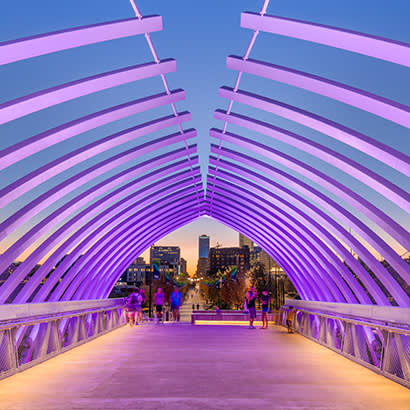
For an enhanced digital experience, read this story in the ezine.
Three local underutilized parks get a lighting facelift
Omaha, Nebraska, is known across the United States as one of the best sources of steak, which is why it has served as the country’s meatpacking center since the 1950s. Although lesser known, Omaha’s riverfront also has been attracting headlines, especially recently since the completion of a $325 million renovation of the city’s downtown parkland.
Known as the Omaha Riverfront Revitalization Project, the 72 acres of parkland that bridges the city’s historic Old Market and north downtown area was revitalized to bring life to three underutilized city parks — Gene Leahy Mall, Heartland of America Park, and Lewis and Clark Landing. The project was made possible through a public-private partnership designed to create a beautiful, entertaining hotspot along the Missouri River that would spur economic activity by connecting the waterfront with the downtown area.
Thanks to the efforts of multiple architectural and engineering firms from across the country working together, City of Omaha was able to create a modern, safe and inviting environment that featured several unique spaces and structures. Most noteworthy are two expansive playgrounds, a performance pavilion, a multi-pool interactive water attraction, and a skating rink that hosts both ice skating and roller skating throughout the year.
Spotlighting the Pier in Full Color
The primary focus of the design team, however, was the Farnam Pier, which offers spectacular views of the river and the downtown skyline. Since the pier already served as a destination point in the city, the goal was to leverage it and make sure it was visible from multiple viewing areas at night.
Joshua Spitzig, IALD, director at Atelier Ten, a New York-based environmental design consulting firm hired for the renovation project, says, “Since the pier acts as a visual anchor at the edge of the park with several paths leading straight to it, the lighting had to be magnetic and iconic. We needed the ability to program many specific colors without creating distracting shadows, so we knew we wanted a quad-chip fixture with great color mixing. We also needed the fixtures to be high output, compact in size and sturdy enough to stand up to the rough Nebraska weather.”
Lighting the pier posed special challenges due to the sheer size and design of the structure. Measuring 204 feet and weighing 250,000 pounds, the pier — with its massive rib-like structure — was installed using a large crane and three oversized trucks that transported the bridge in parts from Houston.
A project of this size and stature required the collective talents of multiple teams. Collaborating with Atelier Ten to bring the riverfront revitalization project to life were OJB Landscape Architecture, Safdie Rabines Architects, RSM Design, Alvine Engineering, Fluidity, HDR, Kiewit Infrastructure Group, Gensler, Miller Electric and Applied Ecological Services.
A Spectacular, Yet Reliable Lighting Solution
To ensure that the right lighting fixtures were chosen, the design team mocked up one of the pier’s giant ribs for a shootout to compare the performance of various brands. Ultimately, the team determined that high output, compact outdoor-rated LED floodlights featuring a unique color system met the specifications for the job. The technology offered more usable colors, including pastels, dedicated whites and dynamic white options, all in the same system.
While the color fixtures were specified for the pier’s main rib structure, they also were used to shoot light horizontally through the lower trusses beneath the pier’s deck. These fixtures feature an internal 100-277VAC power supply, onboard DMX+RDM driver, and wireless DMX technology inside for precise lighting control without the need for additional hardware. The fixtures also come with a 10º narrow beam standard, with optional quick-change spread lenses for wider applications.
To complete the lighting of the Farnam Pier, 96 RGBW (red, green, blue, white) fixtures were used to light the ribs on the structure, while eight RGBW fixtures were installed at the bulkhead under the pier. Seven different lighting motifs were programmed — one for each night of the week — to be shown on the bridge. The colors and designs complement the various flowers and plants used throughout the park.
“The coverage of the pier was even better than we had hoped,” says Spitzig. “From some angles, the ribs look like they are almost glowing from the inside.”
Making Safety a Priority at the Skating Rink
The skating rink posed its own set of lighting challenges because it required very high light levels for safety reasons. In addition, the lights had to be individually dimmable with flexible optics so that they could be changed in the field, if needed.
“Reliability was key,” says Spitzig. “We needed fixtures we could trust to meet the stringent light-level requirements and provide complete coverage of the skating surface, whether it was ice or concrete for roller skating.”
After conducting extensive photometric calculations and in-person tests, Spitzig’s team chose based on output, light quality and dependability outside in the elements.
The optical system and high-power LEDs provide exceptional output and efficacy, as they come with a narrow 5º beam standard with optional quick-change spread lenses for wider applications. They provide up to 16,418 lumens and more than 1,101,000 center candela. In addition, 60 fixtures were mounted in pairs to a custom pole structure that rings the inside of the skate path.
“Thanks to the various fixtures, you can’t help but notice the skating rink or the pier,” says Spitzig. “They have given Omaha exactly what it needed — iconic, well-lit structures that are eye catching, as well as safe.”
Michael Giardina is General Manager at Acclaim Lighting.


